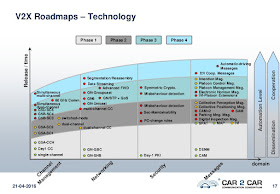ETSI recently held a workshop titled "5G: From Myth to Reality". There were some interesting presentations and discussions, hopefully I will get a chance to write a bit more about it.
One interesting presentation was how 5G will make accident free driving a reality. While the current approach is to use the 802.11p standards that uses the license exempt 5.9GHz band, there is a possibility of enhancements based on 5G
As the final 2 slides say, What could be the use cases for 5G in vehicles? The answer suggested:
- Map update for highly automatic driving - Instantly update the map of vehicle's surrounding. The challenge of this use case is that the vehicle is currently in the tile that needs to be updated, hence a very quick update is required.
- Precise Positioning high speed, no GPS, support for vehicles without high precision location tracking like cars
- Audio / Video Streaming (Entertainment)
- Online Gaming - side jobs
- Sensor- and State Map Sharing (Sensor Raw Data) - Transmit raw sensor data such that others can use their own classifiers to infer decisions
- Camera and Radar sharing to improve visibility, including See-Through Share sensor information to augment ego vehicle's view. Allows for better visibility in presence of obstructing vehicles, heavy rain / fog, etc.
- Short-Term Sensor sharing for crash mitigation - Mitigate crash between multiple vehicle by last-minute traffic exchange
- Traffic forwarding using cars as relays Extend coverage or improve efficiency by using the car as a relay
- Teleoperated Driving "Let car be controlled by off-site driver / car operator e.g. car sharing, taxi operator, …“
- Augemented Reality, e.g. Daytime-Visibility at night)
Here is the complete presentation, let me know what you think:











